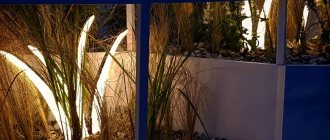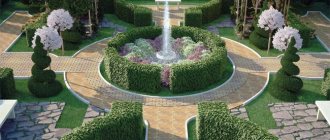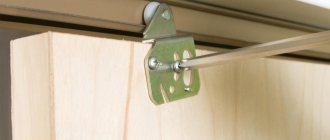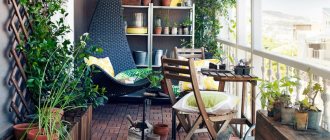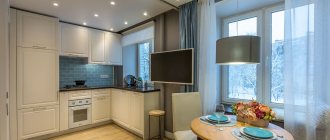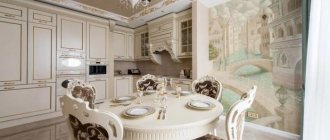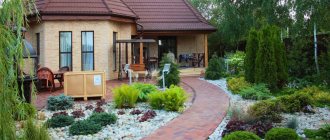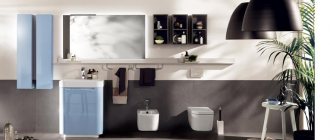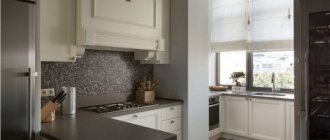Home » Yard and garden
Yard and GardenHouseLandscape Design
Novozhenina Anna
2 comments
A well-kept yard allows you to frame your home favorably, provides self-presentation and the basis for further impressions. Well thought out and organized yard design and landscaping should complement the natural surroundings and continue the interior design intent. Everything will be discussed in more detail later in the article.
Backyard Makeup Ideas
After reviewing the basic rules of landscape design, move on to landscaping the space. Check out the ideas below for landscaping your backyard.
Replace obsolete materials
For this purpose, solid concrete with brick strips is now often used. Make a patio area with concrete, add white sand and add a fountain for dramatic effect.
Enlarge your patio area
A common backyard mistake is making the patio too small. When you're working on your backyard makeover, consider extending the patio to accommodate larger furniture and provide walking around the space.
Patio is a useful yard decoration
Re-paving
Plain gray concrete can be quite boring. Transform your backyard pavers to transform the feel of your entire area. When redoing paving slabs, you have two options: remove the existing sidewalk or transform what you have. Create stains and etchings on the concrete path to make it look like natural stone. If you want to remodel your existing paving, you'll save money on materials and labor.
Low cost garden paths
Don't let small or awkward spaces limit you
Tight spaces can be a challenge and often end up going unused. However, you can transform a narrow space into a backyard fully equipped for outdoor activities. Creative layout and space-saving techniques can be used to fit more features into a small or awkward backyard.
DIY your backyard
You can remodel your backyard yourself, without professionals and their resources, if the matter is limited to feasible work. However, this does not include demolition and installation of new small architectural forms, as this work will take the average homeowner weeks to complete, while a team of professionals can do it in a few days.
Lots of ideas for creating beauty
Projects that involve installing running water, gas, or electrical lines may be additionally complicated. If you want a fountain, a built-in grill, or lots of lighting, it's best to hire a licensed professional. However, when choosing a DIY option that will save you some money, consider planting your own plants. If Make sure you know the requirements for each plant to choose the best location. Consider also installing a patio area yourself.
Dividing the site into zones
After you depict the placement of the planned decorative elements on the site, you need to clearly visualize your idea of the new architectural ensemble. In this case, you need to plan how the individual zones will be demarcated from each other.
For these purposes, it is recommended to use the following methods:
- demarcation by arches;
- use of fencing;
- installation of screens;
- natural delimitation by green spaces.
The choice of method depends on the decorative elements being installed. The garden recreation area can be limited by an arch intertwined with plants. But it is advisable to separate the sports ground with a decorative fence, screen or low picket fence.
Recreation areas can be separated by trellises, complemented by garden trellises. And so that these elements do not stand out too much, it is advisable to decorate them under a green wall. Rattan screens will help not only create a cozy, secluded corner in the yard, but also protect vacationers from the sun or cool wind.
Garden paths help separate thematic areas from each other. For their arrangement, a variety of materials can be used - special slabs, stones, bricks, gravel, cobblestones or pebbles.
For decorative purposes, areas between slabs or stones can be left untreated or covered with sand. Planted low-growing plants will also look good.
It is advisable to give individual areas of the house maximum naturalness, leaving wild plants. Such an area can be paved with tree cuts, the joints of which can be covered with fine gravel or pebbles can be laid.
If your site is characterized by multi-level terrain, then these disadvantages can be turned into advantages. To do this, it is enough to build original steps and transitions.
Patio Design Ideas
Patios are all about outdoor living. You'll likely spend many hours with friends and family on your patio. Instead of purchasing a large home, many people are looking to expand their outdoor living space. The result is a larger, more luxurious and more secure patio area.
Outdoor patios have become hubs of activity, focused on entertainment and relaxation. A well-designed patio will not only add additional living space to your home, but will also increase its resale value.
Organization of a recreation area
Since your patio will provide the foundation for your outdoor living space, it should be durable, well-constructed. There are a variety of patio and paving materials to choose from. Determine what size, shape and style of patio best suits your needs. Use the information here to start collecting ideas for your new patio.
It's time to stop thinking of your patio as just a place to spend time outdoors. It can serve as a hub for a variety of functions including dining, cooking, socializing and relaxation. The style of your patio will change depending on what features you want to accommodate.
Make room for a patio
First, look at your patio decorating options. Relaxing outdoors is one of the most common desires of homeowners. But don’t forget about green spaces , which will become a lush and interesting detail! (vi360Photography)
This project features elegant stone walls. Partitions and floors made from the same material create unity and do not distract from the surrounding vegetation. (Anthony Brancato Landscape Contractor)
The area shown below includes simple outdoor furniture. The bright red color gives it a modern look. Green and landscaped borders are the second key element. The wooden details (fence and bench) also stand out well, making the space look thoughtful and clear. (Creo Landscape Architecture + UrbanDesign)
The following is a 2011 Coty Award-winning project from Tim Johnson. The clients wanted a fun patio. It has water features, beautiful flower beds and garden pots . (Southview Design via Houzz)
The “gazebo”, consisting of a table and chairs, is hidden under a large umbrella. It is perfect for those who love sunny days. An abundance of flowers and evergreen shrubs for the garden contrast with the stone and manicured lawn. (Garden Gate Landscape)
Concrete patios
The durability and versatility of concrete makes it an excellent choice for paving your patio. A concrete patio has many advantages compared to corrugated sheets and other surfaces.
Concrete patio in the courtyard interior
Benefits of concrete patios:
- Highly durable.
- Low operating costs.
- Adaptable to any style.
- Can be poured into any shape.
Decor options:
- Colored concrete. There are several ways to paint concrete, including contrasting, integrating, solid and liquid painting methods (used in combination with embossing), and full staining.
- Embossed Concrete – The surface of your concrete patio can be stamped to create a texture that mimics stone, brick or other materials.
Embossed colored concrete to look like stone
If you already have a patio that is cracked or dirty, you can clean it with concrete. Concrete sanding will make your patio look like new. A reclaimed concrete patio can be painted and stamped.
Another strong trend is to integrate plants into areas where expansion joints would otherwise be located. They help create a more breathable surface and break up the vast structure with greenery. It is not uncommon to use artificial turf in these areas, especially in areas where moisture needs to be maintained.
Grass between seams to maintain moisture
Are concrete patios susceptible to cracking?
Concrete is good for warm climate landscapes that do not experience the extreme freeze-thaw cycles of northern regions that cause uncontrolled cracking. Other factors can also lead to cracking.
This will be of interest to you: Do-it-yourself landscape design for the garden (185+ Photos). Styles You Should Know About
Ideas for gazebos
Gazebos and other shade structures are another way to enjoy nature even if the conditions outside are not the best. During the hot summer, you can relax and have fun outdoors without getting sunstroke. Shade structures also extend the season into fall and winter. If your structure is built with a solid roof or even insulated walls, you can enjoy calm winter mornings while sipping tea without the worry of rain or snow.
Cozy gazebo for summer relaxation
Types of shadow buildings
Gazebos are a self-contained structure, organically placed in the landscape. They can stand on a path and define a space for a walk, or they can define a patio area or outdoor entertaining space. A pergola usually has open sides and a slatted or solid roof.
Pergolas in landscape design
Patio structures are similar to pergolas, except they are attached to the house. This can be an advantage because the patio area can use the house for support and therefore can cost less than a freestanding structure.
Octagonal-shaped gazebos with a durable roof are most often used in traditional gardening areas. They can be an attractive addition if the style of the surrounding landscape works with the structure.
Traditional garden and park area
A canvas canopy is a modern way to get relief from the sun. The fabric is stretched through specially designed posts to accent and cover a seating area or patio. A canvas canopy looks great with the straight lines and simple geometries used in modern homes, and does double duty as a decorative and artistic part of the landscape.
Canopy for gazebo
A screened deck is built right next to the home, usually at the back door for easy access. Instead of glass windows, it has large screens to keep out insects. A screened terrace is great for dining as you get quality time outdoors without any uninvited guests.
A sun room is also being built right next to the house. Because it can be fully insulated and built with two-pane windows, it is a four-season structure that acts as an addition to your home. The sunroom is completely weatherproof, so you can watch birds and wildlife in comfort, even in winter. What really sets a sunroom apart from the rest of your home is that it has lots of windows that enhance outside views.
Lighting a small courtyard of a private house
Properly selected lighting plays an important role when creating landscape design for a small area. With its help, you can make your backyard area attractive not only during the day, but also at night. In addition, with the correct organization of the lighting system, you can hide shortcomings by emphasizing the advantages of the facade of the house and the garden area.
It is worth noting that in the modern design of a site, lighting plays not only a decorative role, but also protects against intruders, guaranteeing good illumination for CCTV cameras, and guarantees safety while moving around the site. For lighting, you can use flashlights and lamps, as well as LED strips, which can be easily installed on any accessible surface.
Terrace decoration
No matter what size backyard you have, you can make the most of the available space and live the dream. Here are some easy DIY landscaping ideas to create a great outdoor space that you can enjoy day and night.
Customize your space with decking
There's nothing like a new deck to transform your backyard into an outdoor living room or a great party spot. It's an easy, affordable way to expand your living space that will last for many years, and with a little know-how, you can build it yourself.
Terrace - a room with flooring
There are several options for decking materials. In addition to traditional wood flooring, there is an eco-friendly alternative. Composite decking can be made from recycled plastic, which is durable, easy to install and maintain, and resistant to rot and pests.
Build with beams
Beams made from environmentally friendly material
You can shape your backyard to any size and give it a natural, earthy look with treated pine beams. Treated pine beams are resistant to decay, fungus and pests, making them one of the most versatile, easy-to-use and hard-wearing landscaping materials on the market. They can be used to create a retaining wall, stepped garden, flower bed or as a border along your beds.
Space with retaining walls
Retaining walls are a great way to create interesting steps for your backyard design. You can use them to create a raised garden to surround your entertaining space or create a quiet corner to unwind. Retaining walls are also a good way to level out areas of sloping block and add extra space for the kids to play or for you to entertain. Depending on the look you want, retaining walls can be made from logs or treated pine sleepers. Use specially formulated wall holding materials that are interlocking, durable and come in a range of colors.
Own paving
You can add real definition to your backyard and create a great look with pavers. Plus, it will be an easy project that you can do yourself. Pavers make a solid base for your outdoor entertaining area, or you can create a path through your garden. There are a variety of colors and installation designs on the market to suit any backyard, from concrete textured pavers, panel pavers, and sand pavers.
Simple and convenient covering for the yard
Add color and texture with pebbles
Pebbles are an easy way to bring different colors and textures to your backyard. You can use it to fill empty spaces in garden beds or as a ground cover to complement a paved or decked area.
For a purely decorative look, you can use pebbles to create a border or landscape path. There are many colors and styles to choose from in white, blue, orange, red, green, lime, silver or gold. Using the same colored pebbles, you can create solid colored areas or mix colors to create a brighter look.
Bright flowerbed using pebbles
Peculiarities
Landscaping of a personal plot can be organized with the help of experienced designers or with your own hands. In any case, before starting to design the site, it is important to plan the territory. To do this, you can see photos of ready-made solutions presented in our article, as well as the work of designers. In addition, it is important to take into account the characteristics of your site and personal wishes, since the site must fully meet the requests and needs of the homeowner.
Unfortunately, when designing a yard, the first thing you need to pay attention to is the size of the area. Often the local area is small, which limits imagination. However, this should not be the case, because even a small courtyard of a private house can be made beautiful, bright and original.
When creating a landscape design, it is important to determine what is most important to the homeowner. For example, if there are small children in the house, then a special role should be given to the arrangement of the playground. For lovers of noisy parties and meetings with friends, there is a recreation area with a gazebo and barbecue; for connoisseurs of beauty, there are flower beds and artificial ponds.
Front yard landscaping
When it comes to decorating your front yard, you'll want to think about what features of your home will be highlighted, as well as how you can transform it into an outdoor space that gets lots of use. If you want to spend your holiday time there, privacy will be key. Privacy can be created with a wall or hedge.
Get a new perspective
Before choosing a project, look at your landscape with fresh eyes and a broader perspective. We are so accustomed to our landscape that it can be difficult to determine what others might see. There are two simple tricks to see the landscape from a new perspective. With both of these methods, the goal is to forget what you think about your landscape and instead look at what actually exists.
The first is an old artist's trick. Get far enough away from your landscape that you can see everything at once. Then squint your eyes until the picture blurs and try to clear your memory.
“Paint” your picture to create a landscape
There may be areas that, when viewed blurredly, appear dark and overgrown. Some areas may look messy because there are too many small plantings, statues or pots. Or, you may have an area that is bright and clean, but a little too empty. All these ideas can give you a general idea of which projects to tackle first.
The second technique you can use to see your landscape with new eyes is to take black and white photographs of your landscaping. By adding color, you can make a familiar space feel new, so you see it with objective eyes. Nowadays, most digital cameras have a black and white setting, so this is easy to do even if you are not a techno genius.
Define boundaries and add mulch
Clean edges deceive the eye, creating a neat and well-kept landscape. If the lawn has encroached into the garden beds and created an uneven line, defining a boundary can improve the appearance of the entire landscape.
Start by laying out a garden hose to define the new boundary. Don't make the beginner mistake of creating a wavy "drunk snake" line. Instead, make wide curves that are scaled to the size of your home. Then use a hoe to cut the grass until you have a clean, attractive line.
Define a beautiful mulch line
Once you've established a neat border, add a layer of wood chip mulch for a sophisticated look. The bright color is attractive, smoothes out uneven soil surfaces and generally gives landscaping a professional finish.
Trim huge bushes
If the plant is clearly not intended to be a hedge, then it needs to be pruned. Otherwise, it will feel like the service is out of control.
Prune the shrub at the base, removing any branches that are within 6 inches of the ground. This gives a more open look and works wonders on Rhododendrons and other shrubs that can appear gloomy and overwhelming when sprawled across the ground.
Neat bushes in the yard of the house
Another good task is to carefully trim any plant that touches the house. Plants that lean against your home can cause paint cracking, as well as mold and ants. Trimming plants 20 to 30cm from the house will give the landscaping a more open look and also give you the opportunity to clean the house or paint it if necessary.
DIY yard landscaping: the best ideas
In our article, we also want to introduce you to simple solutions for arranging a garden that you can implement yourself and at no extra cost. You will learn that things on the site are not limited to planting and watering, and in general there is a huge range of work that needs to be done. However, they are best carried out only from May to September during the dry season.
Backfilling with gravel. This will solve several problems in the design of your site. Firstly, this will help to say goodbye to the soil on paths and terraces forever, because the gravel will stop it, and the earth will not be blown away at the slightest breath of wind. Secondly, you will get mulching that prevents the soil from drying out, and you will be able to water your plants less often. Thirdly, you will implement a designer approach to arranging your flower beds, so they will look twice as good in photos and in life. You will need one 10 liter bag per 50 by 50 cm flower bed.
Minimalist landscape design of the area around the pool Source secretdesignstudio.com
Wooden gazebo on a strip foundation with a brick base. You can build such a gazebo yourself. You need a strip foundation with a depth of 30 cm and another 10 cm on top. It is covered with waterproofing brickwork, which will become the basis for the beams of the screens and roof. Then the wooden frame is assembled and the bench is installed. You can plant shrubs or climbing plants around the gazebo.
The gazebo can be built according to a different principle - without bricks, with anchor bolts on the timber. But this option is less preferable where there will be 30–40 cm of snow in winter, because the wood can rot even with good treatment.
You can also make a gazebo from blocks rather than bricks, however, then you will get a more brutal and bulky structure. However, you can enjoy a very quick and trouble-free construction with a small amount of concrete mortar (which you will have to mix yourself, so if you use less of it, you will save a lot of time).
Wooden gazebo on a brick base in country style Source ircenter.ru
Large terrace made of thermowood on a pile foundation. On a pile foundation, where a beam with waterproofing is placed in a concrete pour of 30 by 30 cm and also 30 cm deep, you can get an excellent terrace. Between the support beam on the foundation and the decking board there will be two layers of guide joists (the first large and the second smaller transverse/perpendicular). Remember that waterproofing and impregnation of the wood itself are the most important details in this matter.
Terrace with gray thermowood and low patio furniture Source southernlivingdesign.ca
Canopy on wooden support poles. In the same way, a canopy can be made on a pile foundation with supporting pillars made of timber and a waterproofing layer. It can be partially mounted on the wall of the house, which will be even more convenient. As a bonus, there is a slope towards the garden necessary for precipitation. It is best to provide drainage (pipes and gutters).
Awnings are needed for terraces, patios, gazebos, porches, children's sandboxes, verandas, and any outdoor dining area. It is best to make a roof from a soft roof. It is more expensive, but the heat from the sun will not interfere with your rest, because polycarbonate and many other materials get very hot.
Modern terrace with a canopy, dining room and patio at the cottage Source warrant-invest.com
Home office in the garden (shed). You can assemble such a frame house yourself or order it from a construction company. Usually, without a foundation and communications measuring 15–20 square meters, it costs approximately 300–400 thousand rubles. This could be your main budget country house for 1–2 people. True, then he will also need a toilet with a septic tank, as well as a summer kitchen with a well and water supply to the sink tap.
Small frame house (barn) Source houzz.it
An outdoor kitchen with a built-in gas grill is always a great idea! The gas grill itself is quite expensive - from 10 thousand rubles for a small one and from 40 thousand rubles for a large, but high-quality one. Such grills are mounted into a countertop on a structure made of stone, brick or blocks. Luxurious grills, as in American TV series, already cost about 80-150 thousand rubles, which is beyond the usual summer cottage budget, but may appeal to those who are building a good-quality cottage or country house.
A summer kitchen usually consists of the following elements: grill, countertop, sink, countertop for small household appliances. You will also need a waste bin and small household appliances (kettle, toaster, mixer, juicer). The cost of implementing such an idea only starts from 50 thousand rubles, and this does not include a grill or barbecue.
Summer kitchen in Mediterranean style with ornaments and mosaics Source refdsg.co
A podium for a canopy or terrace may be the ideal solution for those who want to have a stunning view of their own garden on the terrace - their favorite flower beds, paths, lawn. It's also easier to keep an eye on the kids from above. This design is also good because when it rains, water will definitely not get in and stagnate on the terrace, and will not wet your floorboard to the point where no amount of oil impregnation will save it from rotting.
The podium can also be made for the patio, not just for the dining group. But it is most important to think about shading (from a house, another building or using a textile canopy), since sitting in the sun and even on a hill on a July day is not entirely comfortable.
Terrace on a podium with several steps and a fabric canopy Source cyou.ir
You can build a stone fence with your own hands, but you still can’t do without concrete masonry, which can be laid carefully and disguised with pebbles along the fronts. It can also be decorated with integrated niches in an iron reinforced mesh for the ground, so plants and flowers can be planted as if “between the stones.”
A stone fence can be made in a simpler way. You simply build a fence of brick or ceramic/concrete blocks, and then decorate the façade with decorative stone (slate, limestone, for example). Then you will have a much more practical option. Even “niches” can be made by “skipping” one or two bricks in the masonry.
A picturesque relaxation area in the garden with beautiful lighting on a stone fence Source bbb.org
A flower bed along a terrace or house can bloom almost all year round, and for winter it is worth planting evergreen conifers. It will be visible from several windows of the house, which will add privacy to the rooms from the street side. The perimeter of the flowerbed can be lined with stones, bricks, decorative pebbles or cobblestones.
It is best to make such a flower bed from plants that will bloom at different times of the warm season, so that you always have an attractive flower garden. At soil level, instead of mulch, you can plant ground covers, succulents or sedums, this will prevent the soil from drying out and reduce the amount of water required for irrigation.
Flower bed along the blind area of the terrace, covering the base Source ar.pinterest.com
A decorative pond lined with stone is usually made either on the basis of a composite (plastic) bowl, or on the basis of an ordinary pit with a three-four-layer film for ponds. The film is usually black, which helps the water warm up, but makes the water essentially black or dark brown. The composite bowl is usually blue in color and makes the water transparent, with a noticeable visible blue bottom, which looks more aesthetically pleasing.
Covering with stones is problematic both in the first option (the film breaks) and in the second (the bowl does not provide for a convenient arrangement of stones). It is better to make a landscape pool, which costs more, but looks very stylish.
Decorative pond made of slate Source x-line.by
Trees
The key quality when choosing a tree for your front yard should be its discreet appeal. The right tree can transform a front yard, adding structural interest, seasonal color, shade and dimension. The best tree choice for your front yard depends on factors including your climate, the space you have, preferences, and the orientation of your landscape.
Trees for small spaces
When choosing a tree for a small front yard, look for a specimen that will create a focal point without dominating your home or landscape. There are many small or dwarf tree varieties that will not grow taller than 8 meters, but have eye-catching features that more than make up for their lack of height, such as interesting leaf shapes and unique branch directions. Good options include dogwoods, Japanese maples, cherry trees and purple plum trees.
Decorative trees for small spaces
Blooming
Flowering trees will give your front yard a welcome splash of color after a long winter, often before the rest of the landscape comes to life. The effect will be similar to the shape of a vase full of flowers, providing a temporary but vibrant splash of color and an intoxicating aroma. Many flowering trees also provide multi-season interest, producing colorful berries and vibrant fall foliage such as flowering cherry trees, myrtle, apple trees and eastern redbells.
Shadow
Planting trees for shade in front of your home can block the harsh morning and afternoon sun from pouring into your windows, keeping your home cooler throughout the summer. Their dense canopies of leaves also slow the evaporation of water from lawns and garden beds. Shade trees come in many shapes and sizes, but fast-growing varieties deliver their benefits sooner. Examples include red maple, oak, poplar, birch, and ash.
Slender birch tree on the site near the house
For autumn foliage
Every front yard should have at least one tree that provides dazzling fall color, with leaves that turn seemingly overnight into brilliant shades of yellow, orange, red or purple. Some trees, such as the sugar maple, will produce a kaleidoscope of colors, ranging from yellow to orange and finally to red.
Evergreens
While many deciduous trees will reward you with spring flowers and fall color, their glory often fades in the winter after the leaves have fallen, leaving you with a lifeless landscape. Almost any front yard can benefit from the year-round color and sculptural beauty of conifers.
